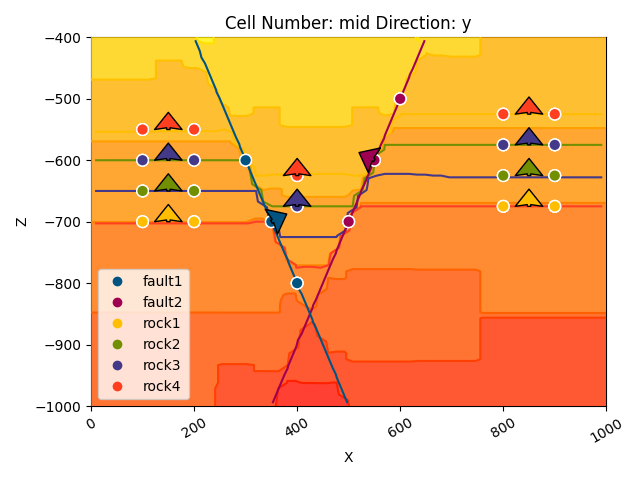Note
Go to the end to download the full example code
1.5: Fault relations¶
Importing gempy
import gempy as gp
import gempy_viewer as gpv
# Aux imports
import numpy as np
import os
np.random.seed(1515)
We import a model from an existing folder.
data_path = os.path.abspath('../../')
geo_model: gp.data.GeoModel = gp.create_geomodel(
project_name='Faults_relations',
extent=[0, 1000, 0, 1000, -1000, -400],
resolution=[20, 20, 20],
refinement=6, # * For this model is better not to use octrees because we want to see what is happening in the scalar fields
importer_helper=gp.data.ImporterHelper(
path_to_orientations=data_path + "/data/input_data/tut-ch1-5/tut_ch1-5_orientations.csv",
path_to_surface_points=data_path + "/data/input_data/tut-ch1-5/tut_ch1-5_points.csv",
)
)
print(geo_model)
{'grid': <gempy.core.data.grid.Grid object at 0x7f08ac52d1b0>,
'interpolation_options': InterpolationOptions(kernel_options={'range': 5, 'c_o': 10, 'uni_degree': 1, 'i_res': 4, 'gi_res': 2, 'number_dimensions': 3, 'kernel_function': <AvailableKernelFunctions.cubic: KernelFunction(base_function=<function cubic_function at 0x7f090b7b1cf0>, derivative_div_r=<function cubic_function_p_div_r at 0x7f090b7b1d80>, second_derivative=<function cubic_function_a at 0x7f090b7b1e10>, consume_sq_distance=False)>, 'compute_condition_number': False, 'kernel_solver': <Solvers.DEFAULT: 1>}, number_octree_levels=6, current_octree_level=0, compute_scalar_gradient=False, mesh_extraction=True, mesh_extraction_masking_options=MeshExtractionMaskingOptions.INTERSECT, mesh_extraction_fancy=True, debug=True, debug_water_tight=False, sigmoid_slope=50000, _number_octree_levels_surface=4),
'meta': GeoModelMeta(name='Faults_relations',
creation_date=None,
last_modification_date=None,
owner=None),
'structural_frame': StructuralFrame(
structural_groups=[
StructuralGroup(
name=default_formation,
structural_relation=StackRelationType.ERODE,
elements=[
Element(
name=fault1,
color=#015482,
is_active=True
),
Element(
name=fault2,
color=#9f0052,
is_active=True
),
Element(
name=rock1,
color=#ffbe00,
is_active=True
),
Element(
name=rock2,
color=#728f02,
is_active=True
),
Element(
name=rock3,
color=#443988,
is_active=True
),
Element(
name=rock4,
color=#ff3f20,
is_active=True
)
]
)
],
fault_relations=
[[False]],
,
'transform': {'_is_default_transform': False,
'position': array([-500., -500., 650.]),
'rotation': array([0., 0., 0.]),
'scale': array([0.000625, 0.000625, 0.000625])}}
One fault model¶
Setting the structural frame
fault1: gp.data.StructuralElement = geo_model.structural_frame.get_element_by_name("fault1")
fault2: gp.data.StructuralElement = geo_model.structural_frame.get_element_by_name("fault2")
# Remove the faults from the default group
default_group: gp.data.StructuralGroup = geo_model.structural_frame.get_group_by_name("default_formation")
default_group.elements.remove(fault1)
default_group.elements.remove(fault2)
# Add a new group for the fault
gp.add_structural_group(
model=geo_model,
group_index=0,
structural_group_name="fault_series_1",
elements=[fault1],
structural_relation=gp.data.StackRelationType.FAULT,
fault_relations=gp.data.FaultsRelationSpecialCase.OFFSET_ALL
)
print(geo_model.structural_frame)
StructuralFrame(
structural_groups=[
StructuralGroup(
name=fault_series_1,
structural_relation=StackRelationType.FAULT,
elements=[
Element(
name=fault1,
color=#015482,
is_active=True
)
]
),
StructuralGroup(
name=default_formation,
structural_relation=StackRelationType.ERODE,
elements=[
Element(
name=rock1,
color=#ffbe00,
is_active=True
),
Element(
name=rock2,
color=#728f02,
is_active=True
),
Element(
name=rock3,
color=#443988,
is_active=True
),
Element(
name=rock4,
color=#ff3f20,
is_active=True
)
]
)
],
fault_relations=
[[False, True],
[False, False]],
geo_model.transform.apply_anisotropy(gp.data.GlobalAnisotropy.NONE)
if False:
gp.compute_model(geo_model)
# %%
print(geo_model.solutions.raw_arrays.block_matrix[0]) # This contains the block values for the fault1
print(geo_model.solutions.raw_arrays.block_matrix[1]) # This contains the block values for the formations
# %%
gpv.plot_2d(geo_model, show_data=True)
gpv.plot_3d(geo_model, show_data=True, kwargs_plot_structured_grid={'opacity': .2})
# TODO: Add example of offsetting just one fault
# %5
# Graben example
# --------------
gp.add_structural_group(
model=geo_model,
group_index=1,
structural_group_name="fault_series_2",
elements=[fault2],
structural_relation=gp.data.StackRelationType.FAULT,
fault_relations=gp.data.FaultsRelationSpecialCase.OFFSET_ALL
)
print(geo_model.structural_frame)
from gempy_engine.core.data.kernel_classes.solvers import Solvers
geo_model.interpolation_options.kernel_options.kernel_solver = Solvers.SCIPY_CG
geo_model.interpolation_options.kernel_options.compute_condition_number = True
gp.compute_model(geo_model)
StructuralFrame(
structural_groups=[
StructuralGroup(
name=fault_series_1,
structural_relation=StackRelationType.FAULT,
elements=[
Element(
name=fault1,
color=#015482,
is_active=True
)
]
),
StructuralGroup(
name=fault_series_2,
structural_relation=StackRelationType.FAULT,
elements=[
Element(
name=fault2,
color=#9f0052,
is_active=True
)
]
),
StructuralGroup(
name=default_formation,
structural_relation=StackRelationType.ERODE,
elements=[
Element(
name=rock1,
color=#ffbe00,
is_active=True
),
Element(
name=rock2,
color=#728f02,
is_active=True
),
Element(
name=rock3,
color=#443988,
is_active=True
),
Element(
name=rock4,
color=#ff3f20,
is_active=True
)
]
)
],
fault_relations=
[[False, True, True],
[False, False, True],
[False, False, False]],
Setting Backend To: AvailableBackends.numpy
/home/leguark/gempy/gempy/core/data/geo_model.py:164: UserWarning: You are using refinement and passing a regular grid. The resolution of the regular grid will be overwritten
warnings.warn(
A size: (14, 14)
CG iterations: 13
A size: (15, 15)
CG iterations: 10
A size: (85, 85)
CG iterations: 68


<gempy_viewer.modules.plot_3d.vista.GemPyToVista object at 0x7f08ac738250>
<gempy_viewer.modules.plot_2d.visualization_2d.Plot2D object at 0x7f08ac85e230>
Finite Faults¶
Faults relations¶
Let’s split the formations in two groups
gp.add_structural_group(
model=geo_model,
group_index=2,
structural_group_name="series_1",
elements=[
geo_model.structural_frame.get_element_by_name("rock4"),
geo_model.structural_frame.get_element_by_name("rock3")
],
structural_relation=gp.data.StackRelationType.ERODE
)
default_group.elements.remove(geo_model.structural_frame.get_element_by_name("rock4"))
default_group.elements.remove(geo_model.structural_frame.get_element_by_name("rock3"))
gp.set_fault_relation(
frame=geo_model.structural_frame,
rel_matrix=np.array([
[0, 1, 1, 1],
[0, 0, 0, 1],
[0, 0, 0, 0],
[0, 0, 0, 0]
]
)
)
print(geo_model.structural_frame)
StructuralFrame(
structural_groups=[
StructuralGroup(
name=fault_series_1,
structural_relation=StackRelationType.FAULT,
elements=[
Element(
name=fault1,
color=#015482,
is_active=True
)
]
),
StructuralGroup(
name=fault_series_2,
structural_relation=StackRelationType.FAULT,
elements=[
Element(
name=fault2,
color=#9f0052,
is_active=True
)
]
),
StructuralGroup(
name=series_1,
structural_relation=StackRelationType.ERODE,
elements=[
Element(
name=rock4,
color=#ff3f20,
is_active=True
),
Element(
name=rock3,
color=#443988,
is_active=True
)
]
),
StructuralGroup(
name=default_formation,
structural_relation=StackRelationType.FAULT,
elements=[
Element(
name=rock1,
color=#ffbe00,
is_active=True
),
Element(
name=rock2,
color=#728f02,
is_active=True
)
]
)
],
fault_relations=
[[False, True, True, True],
[False, False, False, False],
[False, False, False, False],
[False, False, False, False]],
Setting Backend To: AvailableBackends.numpy
A size: (14, 14)
CG iterations: 13
A size: (15, 15)
CG iterations: 10
A size: (50, 50)
CG iterations: 100
A size: (38, 38)
CG iterations: 38


<gempy_viewer.modules.plot_3d.vista.GemPyToVista object at 0x7f08f5696bc0>
Total running time of the script: (0 minutes 22.102 seconds)



